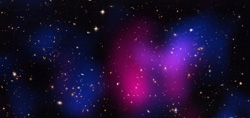Discovery of the Musket Ball Cluster



X-ray: NASA/CXC/UCDavis/W.Dawson et al; Optical: NASA/STScI/UCDavis/W.Dawson et al.<br> <br>This composite image shows Chandra (red) and Hubble (yellow and white) data of the galaxy cluster system that has been nicknamed the "Musket Ball" cluster. Astronomers call it this because the newly discovered cluster is older and slower than the Bullet Cluster, a famous system in which "normal" matter has been wrenched apart from dark matter. Chandra detects the normal matter as hot gas, while optical emission reveals the presence of dark matter through the effect of gravitational lensing (blue). DLSCL J0916.2+2951 is further along in its evolution than the Bullet Cluster, giving scientists valuable insight into a different phase of how galaxy clusters -- the largest known objects held together by gravity -- grow and change after major collisions.<br>
The newly discovered galaxy cluster is called DLSCL J0916.2+2951. It is similar to the Bullet Cluster, the first system in which the separation of dark and normal matter was observed, but with some important differences. The newly discovered system has been nicknamed the “Musket Ball Cluster” because the cluster collision is older and slower than the Bullet Cluster.
Finding another system that is further along in its evolution than the Bullet Cluster gives scientists valuable insight into a different phase of how galaxy clusters – the largest known objects held together by gravity – grow and change after major collisions. Researchers used observations from NASA's Chandra X-ray Observatory and Hubble Space Telescope as well as the Keck, Subaru and Kitt Peak Mayall telescopes to show that hot, X-ray bright gas in the Musket Ball Cluster has been clearly separated from dark matter and galaxies.
In this composite image, the hot gas observed with Chandra is colored red, and the galaxies in the optical image from Hubble appear as mostly white and yellow. The location of the majority of the matter in the cluster (dominated by dark matter) is colored blue. When the red and the blue regions overlap, the result is purple as seen in the image. The matter distribution is determined by using data from Subaru, Hubble and the Mayall telescope that reveal the effects of gravitational lensing, an effect predicted by Einstein where large masses can distort the light from distant objects.
In addition to the Bullet Cluster, five other similar examples of merging clusters with separation between normal and dark matter and varying levels of complexity, have previously been found. In these six systems, the collision is estimated to have occurred between 170 million and 250 million years earlier.
In the Musket Ball Cluster, the system is observed about 700 million years after the collision. Taking into account the uncertainties in the age estimate, the merger that has formed the Musket Ball Cluster is two to five times further along than in previously observed systems. Also, the relative speed of the two clusters that collided to form the Musket Ball cluster was lower than most of the other Bullet Cluster-like objects.
The special environment of galaxy clusters, including the effects of frequent collisions with other clusters or groups of galaxies and the presence of large amounts of hot, intergalactic gas, is likely to play an important role in the evolution of their member galaxies. However, it is still unclear whether cluster mergers trigger star formation, suppress it, or have little immediate effect. The Musket Ball Cluster holds promise for deciding between these alternatives.
The Musket Ball Cluster also allows an independent study of whether dark matter can interact with itself. This information is important for narrowing down the type of particle that may be responsible for dark matter. No evidence is reported for self-interaction in the Musket Ball Cluster, consistent with the results for the Bullet Cluster and the other similar clusters.
The Musket Ball Cluster is located about 5.2 billion light years away from Earth. Findings on the Musket Ball Cluster were presented at the American Astronomical Society meeting in Austin, TX in January by Will Dawson from the University of California, Davis.
A paper describing these results led by Dawson was published in the March 10, 2012 issue of The Astrophysical Journal Letters. The other co-authors were David Wittman, M. James Jee and Perry Gee from UC Davis, Jack Hughes from Rutgers University in NJ, J. Anthony Tyson, Samuel Schmidt, Paul Thorman and Marusa Bradac from UC Davis, Satoshi Miyazaki from the Graduate University for Advanced Studies (GUAS) in Tokyo, Japan, Brian Lemaux from UC Davis, Yousuke Utsumi from GUAS and Vera Margoniner from California State University, Sacramento.
NASA's Marshall Space Flight Center in Huntsville, Ala., manages the Chandra program for NASA's Science Mission Directorate in Washington. The Smithsonian Astrophysical Observatory controls Chandra's science and flight operations from Cambridge, Mass.
Media Contact
More Information:
http://www.cfa.harvard.eduAll latest news from the category: Physics and Astronomy
This area deals with the fundamental laws and building blocks of nature and how they interact, the properties and the behavior of matter, and research into space and time and their structures.
innovations-report provides in-depth reports and articles on subjects such as astrophysics, laser technologies, nuclear, quantum, particle and solid-state physics, nanotechnologies, planetary research and findings (Mars, Venus) and developments related to the Hubble Telescope.
Newest articles

Superradiant atoms could push the boundaries of how precisely time can be measured
Superradiant atoms can help us measure time more precisely than ever. In a new study, researchers from the University of Copenhagen present a new method for measuring the time interval,…

Ion thermoelectric conversion devices for near room temperature
The electrode sheet of the thermoelectric device consists of ionic hydrogel, which is sandwiched between the electrodes to form, and the Prussian blue on the electrode undergoes a redox reaction…

Zap Energy achieves 37-million-degree temperatures in a compact device
New publication reports record electron temperatures for a small-scale, sheared-flow-stabilized Z-pinch fusion device. In the nine decades since humans first produced fusion reactions, only a few fusion technologies have demonstrated…





















